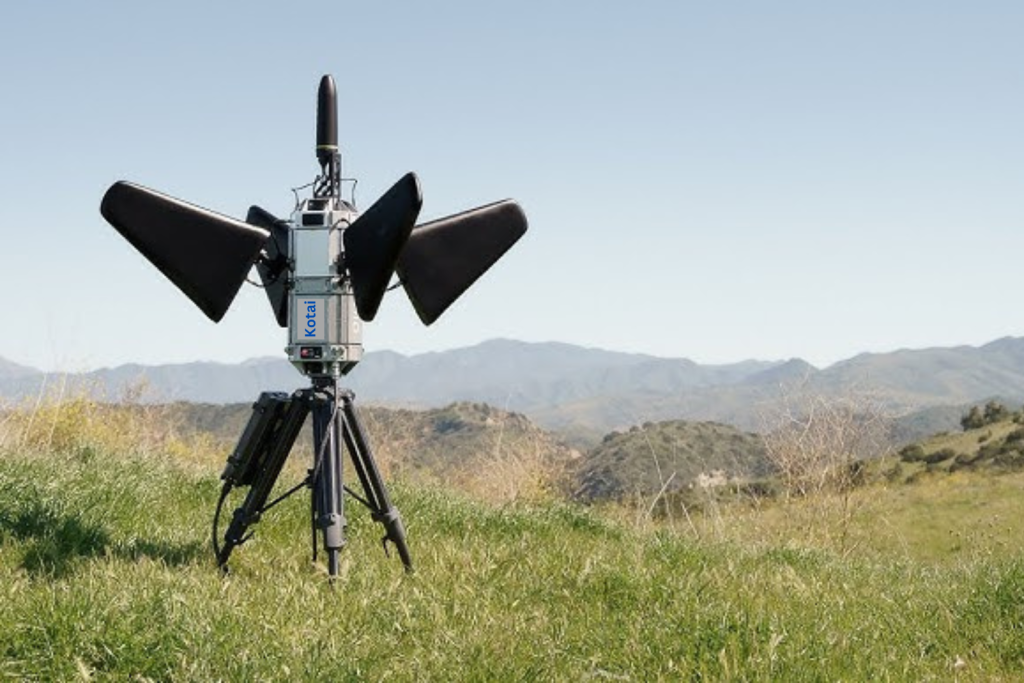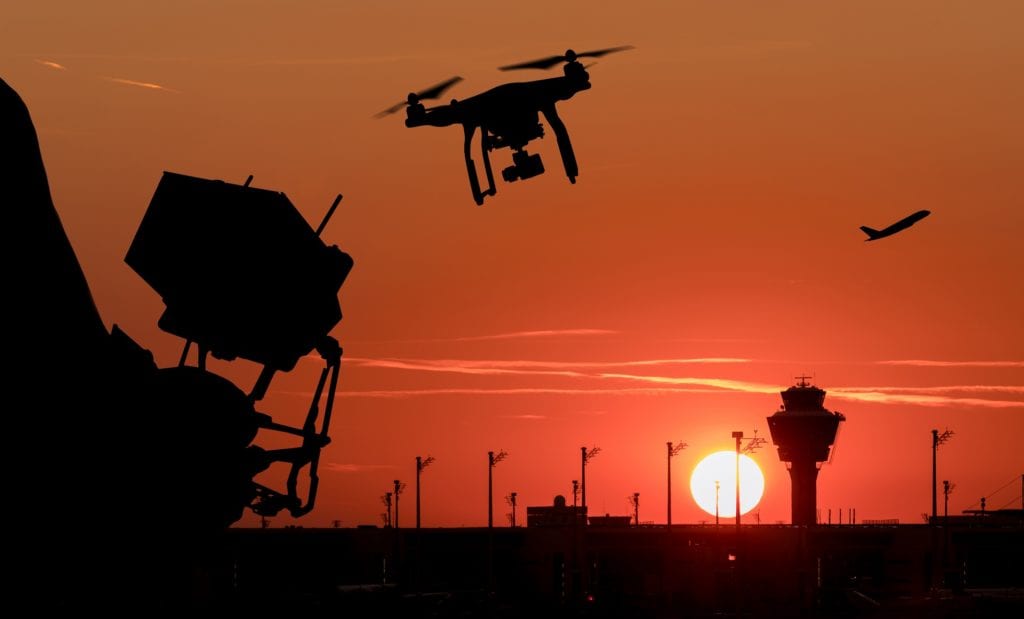KERF007 vs Global CUAS System
Counter-Unmanned Aerial Systems (C-UAS) are becoming a key component of current security infrastructure in a time when unmanned aerial vehicles (UAVs) are becoming more widely available and common. CUAS systems are now required for everything from securing business property and public gatherings to defending military facilities and important government infrastructure.
While a few nations are at the cutting edge of the global anti-drone system development process, India is making important developments thanks to its own creativity. Kotai Electronics’ KERF007, a fully integrated, AI-powered, Made-in-India anti-drone system, is one such example. This paper examines how KERF007 compares to the top C-UAS solutions available worldwide and explains why it is a unique next-generation option for drone threat detection, monitoring, and neutralization.
Table of Contents
Understanding the Global CUAS Landscape
Global CUAS systems are developed by some of the most advanced defense and aerospace companies in the world, including:
- Dedrone (USA/Germany)
- DroneShield (Australia)
- Raytheon (USA)
- Leonardo (Italy)
- Rafael (Israel)
- Hensoldt (Germany)
- SRC Inc. (USA)
Complex sensor suites, radar technology, jammers, radio frequency detectors, and electro-optical cameras are all integrated into these systems. They have high capital and operating expenses, are very modular, and frequently call for the deployment of several units throughout a certain area.
Although they provide strong solutions, a large number of them are made for military-grade applications and are not very affordable or customizable to meet local or regional security requirements.
Introducing KERF007 by Kotai Electronics
Kotai Electronics created the Made-in-India integrated counter-drone system KERF007 with the express purpose of meeting regional security demands while utilizing state-of-the-art capabilities and minimizing prices. The system includes:
- 4D Radar
- Electro-optical and thermal camera
- LPU (Local Processing Unit)
- AI-Powered Software
- Integrated Drone Jammer
Unlike many global systems that deploy these components separately, KERF007 integrates them into a single, compact unit, providing seamless detection, monitoring, and disruption capabilities.

Feature-by-Feature Comparison: KERF007 vs Global Systems
Let’s break down the features and compare KERF007 with the leading global CUAS technologies.
1. Integration & Design
Global CUAS Systems:
Most global systems use modular components that require integration at the deployment site. This leads to complexity in deployment, increases logistics, and requires trained employees for setup and calibration.
KERF007 by Kotai:
Offers a fully integrated device with 4D radar, camera, jammer, and processing unit all in one. It reduces installation time and simplifies deployment, especially for quick-response needs in urban and sensitive environments.
Advantage: KERF007 offers ease of deployment and plug-and-play setup, making it suitable for both temporary and permanent installations.
2. Detection Range & Accuracy
Global Systems:
Detection ranges vary between 1 km to 5 km, depending on radar size, elevation, and environment. Many use 2D or 3D radars.
KERF007:
Features a 4D radar capable of detecting drones up to 3 km range in 360-degree coverage. The 4D radar offers superior tracking by providing real-time data on position, altitude, direction, and speed.
Advantage: The 4D radar in KERF007 adds enhanced situational awareness without the need for multiple radar units.
3. Monitoring & Visualization
Global Systems:
Systems like Dedrone and DroneShield offer AI dashboards with visual mapping and drone classification.
KERF007:
Utilizes real-time Google Maps-based visualization, showing incoming drones’ location and flight path. The AI software enables automatic classification and tracking, feeding into mission dashboards for centralized monitoring.
Advantage: For Indian users and agencies, Kotai’s technology provides real-time, intelligent satellite imagery knowledge.
4. Disruption and Neutralization Capability
Global Systems:
Some systems use RF jamming, GNSS spoofing, or kinetic interceptors. However, these are often separate modules and may not be fully autonomous.
KERF007:
Comes with an integrated RF jammer capable of neutralizing drones from 500 meters up to 2 km, customizable up to 5 km range in 360-degree direction. It is also AI-powered for autonomous disruption, reducing the need for manual intervention.
Advantage: KERF007 delivers effective autonomous jamming in a compact format without reliance on external components.
5. AI and Autonomy
Global Systems:
AI functionality varies. Some offer automation in drone identification, while others require semi-manual response modes.
KERF007:
Incorporates advanced AI algorithms for drone scanning, classification, threat prioritization, and automated interference—all in real time.
Advantage: End-to-end automation from detection to disruption enhances operational efficiency, especially in environments with limited manpower.
6. Local Adaptability & Customization
Global Systems:
While powerful, many systems are built with NATO or Western operational protocols, making localization complex and expensive.
KERF007:
It is fully customizable, with modular software and hardware, designed with India’s terrain, spectrum regulations, and defense standards in mind. It also supports integration with mission planning tools and Indian command-and-control platforms.
Advantage: Purpose-built for Indian scenarios—better support, easier compliance, and localized deployment.
7. Cost and Accessibility
Global Systems:
Costs are often high due to import duties, proprietary licensing, and specialized components sourced internationally.
KERF007:
Being made in India, KERF007 offers a significantly lower cost of ownership, with easy access to parts, service, and upgrades.
Advantage: Affordable for Indian police, private security, and even infrastructure providers without compromising quality.

Applications of KERF007 in India and Beyond
Military and Defence
- Forward border posts
- Air bases and naval installations
- Anti-drone perimeter defense
Police and Paramilitary
- Crowd control and riot protection
- VIP protection and convoy security
Critical Infrastructure
- Power plants, airports, and oil depots
- Government buildings and monuments
Commercial and Civilian Use
- Industrial areas
- Event venues and stadiums
- Private estates and high-value properties
By serving both strategic and tactical roles, KERF007 is suitable for both high-level military use and widespread civilian deployment.
Kotai Electronics: An Emerging Leader in Drone Defense
Kotai Electronics has rapidly positioned itself as a trusted anti-drone system manufacturer in India, with a focus on innovation, reliability, and cost-effectiveness.
Key Strengths:
- R&D Driven Approach: Core focus on indigenous technology development
- Made in India Mission: Fully designed and manufactured in India
- AI-Integrated Security Solutions: Pioneering AI-based autonomous defense
- Scalability: From fixed installations to mobile units
Unlike foreign OEMs, Kotai provides on-ground support, faster service cycles, and regulatory compliance with Indian spectrum and safety norms.

What Makes KERF007 Future-Proof?
- Expandable Disruption Range – Customizable up to 5KM
- 360-Degree Situational Awareness – Real-time scanning
- Mission Planning Dashboard – Complete control for command centers
- Multiple Communication Modes – Ready for networked defense
- AI Learning Capabilities – Self-updating threat profiles
These make KERF007 not just a product, but a platform for the future of airspace security in India and the global south.
Conclusion: Why KERF007 Stands Out
Global CUAS systems offer battlefield-tested performance and impact authenticity, but KERF007 exceeds custom by combining intelligence, innovation, and integration into a single Indian-made package. It is an opponent in the anti-drone sector due to its full-stack capabilities, cost-effectiveness, and adaptability.
The KERF007 from Kotai Electronics is the top choice for governments, private security companies, and other organizations looking for high-performance anti-drone defense with regional support and cost.
Looking Ahead
As drone threats change, from smuggling and surveillance to terrorism and swarm attacks, solutions like KERF007 will help define the next phase of proactive security. Thanks to Indian engineering and AI-led innovation, it has the potential to become the premier CUAS platform for emerging markets globally, not just in India.

